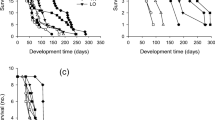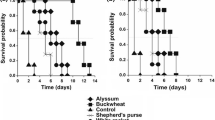Abstract
The perennial stinging nettle (Urtica dioica L.) is a wild plant that provides resources for aphid natural enemies and can therefore benefit crop protection. Stinging nettles producing approximately three times more fibre than Standard nettles are under commercial development for fibre production. Here we assess the relative value of Austrian Clone 2, a high fibre nettle variety, as a resource for the nettle aphid Microlophium carnosum (Buckton) and its associated natural enemies. The intrinsic rate of increase of M. carnosum cultured on Clone 2 was not different to that on a Standard nettle nor was there an effect of nettle variety on the susceptibility of this aphid to the entomopathogenic fungus Pandora neoaphidis (Remaudière and Hennebert) Humber. The development time of the aphidophagous predator Chrysoperla carnea (Stephens) was not affected by the nettle variety on which M. carnosum was cultured whilst the parasitoid Aphidius ervi (Haliday) fed on honeydew produced by M. carnosum infesting both varieties of nettle. Fibre nettle Clone 2 is therefore able to support non-pest aphids and their natural enemies and, if grown widely in the future, may be useful within conservation biological control and a tool within integrated pest management.

Similar content being viewed by others
References
Alhmedi A, Haubruge E, Bodson B, Francis F (2007) Aphidophagous guilds on nettle (Urtica dioica) strips close to fields of green pea, rape and wheat. Insect Sci 14:419–424
Alhmedi A, Haubruge E, Francis F (2009) Effects of stinging nettle habitats on aphidophagous predators and parasitoids in wheat and green pea fields with special attention to the invader Harmonia axyridis Pallas (Coleoptera: Coccinellidae). Entomol Sci 12:349–358
Bacci L, Baronti S, Predieri S, di Virgilio N (2009) Fiber yield and quality of fiber nettle (Urtica dioica L.) cultivated in Italy. Ind Crop Prod 29:480–484
Baverstock J, Baverstock KE, Clark SJ, Pell JK (2008) Transmission of Pandora neoaphidis in the presence of co-occurring arthropods. J Invertebr Pathol 98:356–359
Bredemann G (1959) Die groβe Brennessel Urtica dioica L. Forschung über ihren Anbau zur Fasergewinnung. Akademieverlag, Berlin, Germany
Brown RD, Pimentel D, Byrne HD (1969) Intrinsic rate of increase of the pea aphid on resistant and susceptible alfalfa. J Econ Entomol 62:1521–1522
Cortesero AM, Stapel JO, Lewis WJ (2000) Understanding and manipulating plant attributes to enhance biological control. Biol Control 17:35–49
Davis BNK (1991) Insects on nettles. Richmond Publishing, Slough, UK
Dixon AFG (1998) Aphid ecology. Chapman and Hall, London, UK
Eigenbrode SD, Kabalo NN, Kimberley AS (1999) Predation, behaviour, and attachment by Chrysoperla plorabunda larvae on Brassica oleracea with different surface waxblooms. Entomol Exp Appl 90:225–235
Ekesi S, Shah PA, Clark SJ, Pell JK (2005) Conservation biological control with the fungal pathogen Pandora neoaphidis: implications of aphid species, host plant and predator foraging. Agric For Entomol 7:21–30
England S, Evans EW (1997) Effects of pea aphid (Homoptera: Aphididae) honeydew on longevity and fecundity of the alfalfa weevil (Coleoptera: Curculionidae) parasitoid Bathyplectes curculionis (Hymenoptera: Ichneumonidae). Environ Entomol 26:1437–1441
Giles KL, Madden RD, Payton ME, Dillwith JW (2000) Survival and development of Chrysoperla rufilabris (Neuroptera: Chrysopidae) supplied with pea aphids (Homoptera: Aphididae) reared on alfalfa and faba bean. Environ Entomol 29:304–311
Giles KL, Madden RD, Stockland R, Payton ME, Dillwith JW (2002) Host plants affect predator fitness via the nutritional value of herbivore prey: investigation of a plant-aphid-ladybeetle system. BioControl 47:1–21
Gurr GM, Wratten SD, Luna JM (2003) Multi-function agricultural biodiversity: pest management and other benefits. Basic Appl Ecol 4:107–116
Hartl A, Vogl CR (2002) Dry matter and fiber yields and the fiber characteristics of five nettle Clones (Urtica dioica L.) organically grown in Austria for potential textile use. Am J Altern Agric 17:195–200
Kean JM, Müller CB (2004) Can competition explain local rarity of a nettle aphid? Ecol Entomol 29:706–710
Kenward MG (1987) A method for comparing profiles of repeated measurements. Appl Stat 36:296–308
Köhler K, Schmidtke K, Rauber R (1999) Eignung verschiedener pflanzenarten zur untersaat in fasernesseln (Urtica dioica L.). In: Hoffmann H, Müller S (eds) Beiträge zur 5. Wissenschaftstagung zum Ökologischen Landbau. Köster Verlag, Berlin, Germany, pp 496–500
Leatemia JA, Liang JE, Corrigan JE (1995) Effects of adult nutrition on longevity, fecundity and offspring sex ratio of Trichogramma minutum Riley (Hymenoptera Trichogrammatidae). Can J Entomol 127:245–254
MacLeod A (1999) Attraction and retention of Episyrphus balteatus DeGeer (Diptera: Syrphidae) at an arable field margin with rich and poor floral resources. Agric Ecosyst Environ 73:237–244
Marshall EJP, West TM, Kleijn D (2006) Impacts of an agri-environment field margin prescription on the flora and fauna of arable farmland in different landscapes. Agric Ecosyst Environ 113:36–44
Meek B, Loxton D, Sparks T, Pywell R, Pickett H, Nowakowski M (2002) The effect of arable field margin composition on invertebrate biodiversity. Biol Conserv 106:259–271
Michels GJ, Behle RW (1989) Influence of temperature on reproduction, development and intrinsic rate of increase of Russian wheat aphid, greenbug and bird-cherry-oat aphid (Homoptera: Aphididae). J Econ Entomol 82:439–444
Payne RW, Harding SA, Murray DA, Soutar DM, Baird DB, Welham SJ, Kane AF, Gilmour AR, Thompson R, Webster R, Tunnicliffe-Wilson G (2008) GenStat® Release 11 Reference Manual. VSN International, Hemel Hempstead, Hertfordshire, UK
Perng JJ (2002) Life history traits of Aphis gossypii Glover (Hom., Aphididae) reared on four widely distributed weeds. J Appl Entomol 126:97–100
Perrin RM (1976) The population dynamics of the stinging nettle aphid, Microlophium carnosum (Bukt.). Ecol Entomol 1:31–40
Powell W, Hara SA, Harling R, Holland JM, Northing P, Thomas CFG, Walters KFA (2004) Managing biodiversity in field margins to enhance integrated pest control in arable crops (‘3-D Farming’ Project). HGCA Project report No. 356. HGCA, London, UK
Rand A, Tscharntke T (2007) Contrasting effects of natural habitat loss on generalist and specialist aphid natural enemies. Oikos 116:1353–1362
Shah PA, Clark SJ, Pell JK (2004) Assessment of aphid host range and isolate variability in Pandora neoaphidis (Zygomycetes : Entomophthorales). Biol Control 29:90–99
Singh R, Singh K, Upadhyay BS (2000) Honeydew as a food source for an aphid parasitoid Lipolexis scutellaris Mackauer (Hymenoptera : Braconidae). J Adv Zool 21:77–83
Tkaczuk C, Shah PA, Clark SJ, Pell JK (2007) Influence of host plant on susceptibility of the aphid Acyrthosiphon pisum (Hemiptera: Aphididae) to the fungal pathogen Pandora neoaphidis (Zygomycetes: Entomophthorales). Eur J Entomol 104:205–210
Wäckers FL (2000) Do oligosaccharides reduce the suitability of honeydew for predators and parasitoids? A further facet to the function of insect-synthesized honeydew sugars. Oikos 90:197–201
Wäckers FL (2001) A comparison of nectar- and honeydew sugars with respect to their utilization by the hymenopteran parasitoid Cotesia glomerata. J Insect Physiol 47:1077–1084
Wilding N (1973) The survival of Entomopthora spp. in mummified aphids at different temperatures and humidities. J Invertebr Pathol 21:309–311
Wyatt IJ, White PF (1977) Simple estimation of intrinsic increase rates for aphids and tetranychid mites. J Appl Ecol 14:757–766
Wyckhuys KAG, Strange-George JE, Kulhanek CA, Wäckers FL, Heimpel GE (2008) Sugar feeding by the aphid parasitoid Binodoxys communis: how does honeydew compare with other sugar sources? J Insect Physiol 54:481–491
Zabel J, Tscharntke T (1998) Does fragmentation of Urtica habitats affect phytophagous and predatory insects differentially? Oecologia 116:419–425
Acknowledgments
J. B. and J. K. P. are supported by the Department for Environment, Food and Rural Affairs of the United Kingdom (Defra). Rothamsted Research is an Institute of the Biotechnology and Biological Sciences Research Council of the United Kingdom.
Author information
Authors and Affiliations
Corresponding author
Additional information
Handling Editor: Arne Janssen
Rights and permissions
About this article
Cite this article
Baverstock, J., Porcel, M., Clark, S.J. et al. Potential value of the fibre nettle Urtica dioica as a resource for the nettle aphid Microlophium carnosum and its insect and fungal natural enemies. BioControl 56, 215–223 (2011). https://doi.org/10.1007/s10526-010-9330-x
Received:
Accepted:
Published:
Issue Date:
DOI: https://doi.org/10.1007/s10526-010-9330-x




